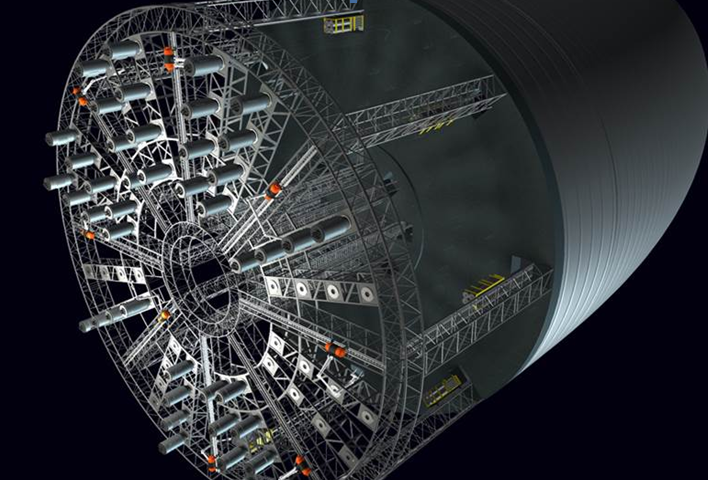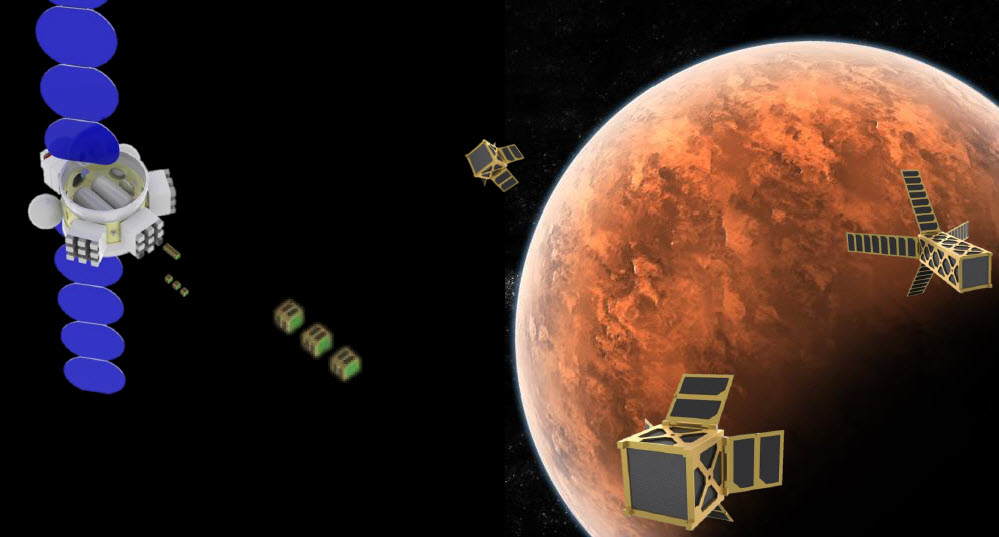Robotic space-colony construction, cubesats for Mars, transhumanists on space, and more….
May 22, 2013
The International Space Development Conference (ISDC), produced by the National Space Society (NSS) — the happening place to learn about the future of space — kicks off Thursday May 23 and runs through Monday May 27 at the Hyatt Regency La Jolla in San Diego, California. ISDC speakers will discuss a wide range of breakthroughs in space development. Here are just two that I find especially interesting. (Full disclosure: I’m a former member of the NSS board of directors.).
A robotic-manufactured space colony

Artist’s concept of docking area for a jig factory in space (credit: Art: Anna Nesterova, concept: John Strickland
John Strickland, National Space Society board member, will present a plan for the “biggest construction system in history,” capable of building space colonies with as much as 500 square miles of ‘land,’ with forests, farms, and whole towns.
It’s a “jig-construction” device — a free-floating factory in space that holds on to the structure that it is making and anchors it, keeping the structure motionless while it is being assembled. At intervals, it extrudes the finished structure at one end.
It also has docks for space tugs, to receive shipments of fresh materials, like metal components created from asteroids and moon dust. The construction system would be automated and heavily roboticized — 3D printing in space with a vengeance.

Artist’s concept of small space colony (credit: Don Davis/NASA Ames Research Center)
Says Strickland, “If the ancient Egyptians had had these jig construction systems and a few million years, they could have built pyramids the size of the moon. Of course they would have been required to build them in space.”
Strickland’s ISDC talk is at 2 pm on May 24 in San Diego, California, at the Hyatt Regency La Jolla at Aventine Hotel. It will be a part of a series of talks that will unveil the National Space Society’s new Roadmap to Space Settlement, a document 12 years in the making.
Cubesats to Mars

(Credit: Busek Inc.)
Aerospace engineer Gary Stephenson will present (10:40 am Friday, Delphi Room) a new concept called “Cubesats to Mars” — a private, not-for-profit venture using tiny cubesats to create a low-cost satellite system for Mars. The cubesats could be used for communication, atmospheric and weather observation, and GPS-like navigation, for example.
The cubesats could be developed by students and would allow small countries to mount their own Mars missions at very low cost. The cubsats could also support future government missions with crucial data and infrastructure.
Transhumanism in space
The ISCD Transhumanist Track will be held on Saturday, May 25, 2013. organized by Dr. Natasha Vita-More and Karen Mermel. It will feature two of my favorite science-fiction writers, Dr. David Brin and Dr. Vernor Vinge; David Orban on what Maori culture can teach a future starfaring civilization; Vita-More on biotech innovations in space, and Howard Bloom in a new illustrated talk presenting his imaginative vision of “Gardening Space: Retooling Mind, Rewiring Reality.”
Transhumanist Track
| TIME (Talk + Q&A) | SPEAKER NAME | TALK TITLE |
| 10:00 – 10:50 | David Brin | “Are space travel and transhumanism compatible? Is it one or the other? All or nothing? The star-lanes appear to be more empty than expected. Does that represent opportunity for Earthclan? Or danger?” |
| 11:05 – 11:55 | Natasha Vita-More | “Innovations of Life Expansion: seizing the biotech moment and making it last—indefinitely!” |
| LUNCH BREAK | ||
| 2:00 – 2:50 | Panel: Brin, Orban, Vinge, Vita-More | “Impending Narratives from Cybernetics to Transhuman Ethics: What are We? Where are we Headed? Who is in Control?” |
| 3:05 – 3:55 | David Orban | “What Can Maori Culture Teach to a Future Starfaring Civilization? The careful design of appropriate memetic components can maximize the fitness of cultural units in long term isolation.” |
| 4:05 – 4:55 | Howard Bloom | “Gardening Space: Retooling Mind, Rewiring Reality” |
| 5:05 – 6:00 | Open Discussion |
